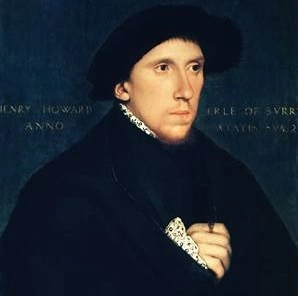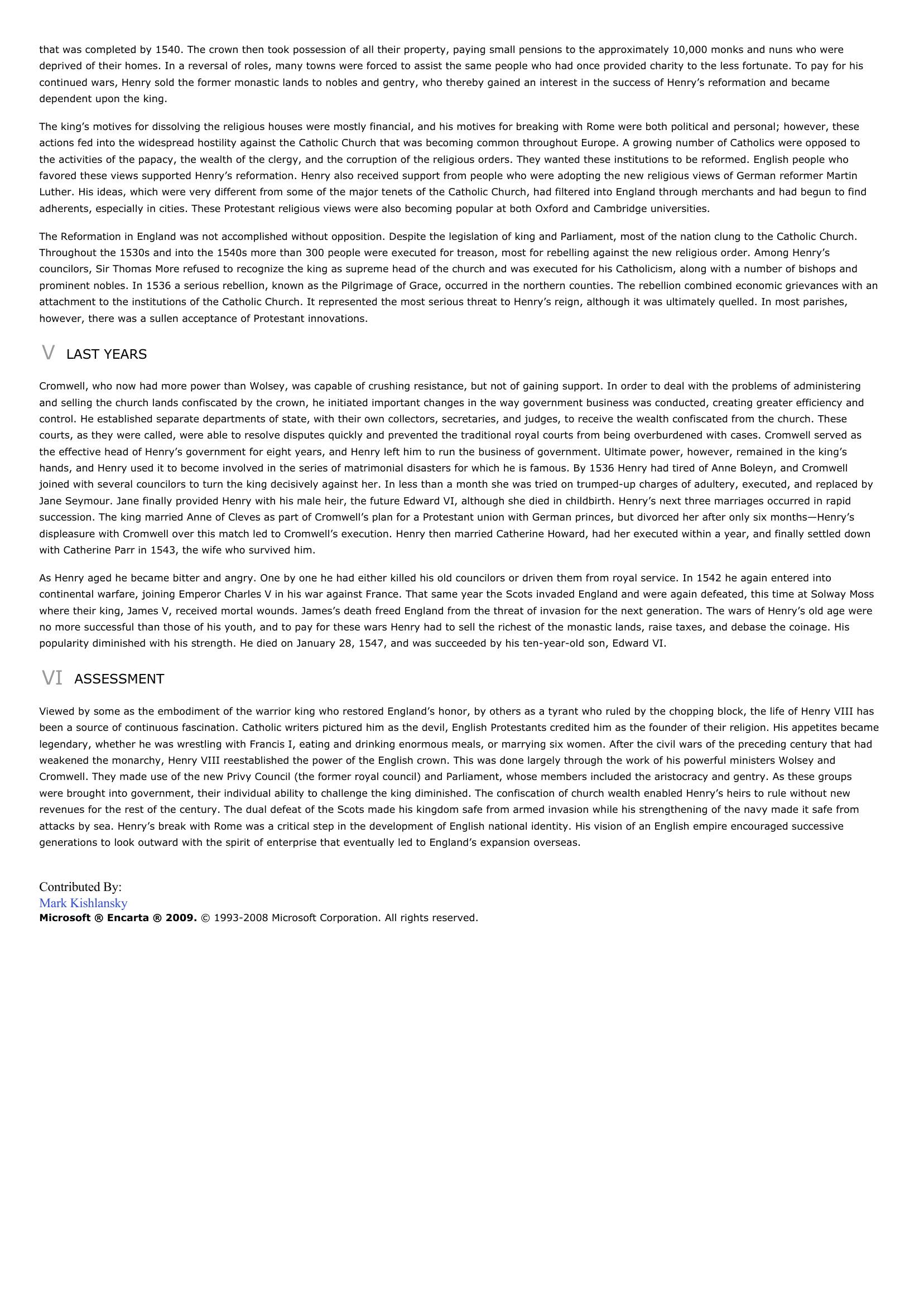Henry VIII I INTRODUCTION Henry VIII (1491-1547), king of England (1509-1547), the image of the Renaissance king as immortalized by German artist Hans Holbein, who painted him hands on hips, legs astride, exuding confidence and power.
Publié le 10/05/2013

Extrait du document


«
that was completed by 1540.
The crown then took possession of all their property, paying small pensions to the approximately 10,000 monks and nuns who weredeprived of their homes.
In a reversal of roles, many towns were forced to assist the same people who had once provided charity to the less fortunate.
To pay for hiscontinued wars, Henry sold the former monastic lands to nobles and gentry, who thereby gained an interest in the success of Henry’s reformation and becamedependent upon the king.
The king’s motives for dissolving the religious houses were mostly financial, and his motives for breaking with Rome were both political and personal; however, theseactions fed into the widespread hostility against the Catholic Church that was becoming common throughout Europe.
A growing number of Catholics were opposed tothe activities of the papacy, the wealth of the clergy, and the corruption of the religious orders.
They wanted these institutions to be reformed.
English people whofavored these views supported Henry’s reformation.
Henry also received support from people who were adopting the new religious views of German reformer MartinLuther.
His ideas, which were very different from some of the major tenets of the Catholic Church, had filtered into England through merchants and had begun to findadherents, especially in cities.
These Protestant religious views were also becoming popular at both Oxford and Cambridge universities.
The Reformation in England was not accomplished without opposition.
Despite the legislation of king and Parliament, most of the nation clung to the Catholic Church.Throughout the 1530s and into the 1540s more than 300 people were executed for treason, most for rebelling against the new religious order.
Among Henry’scouncilors, Sir Thomas More refused to recognize the king as supreme head of the church and was executed for his Catholicism, along with a number of bishops andprominent nobles.
In 1536 a serious rebellion, known as the Pilgrimage of Grace, occurred in the northern counties.
The rebellion combined economic grievances with anattachment to the institutions of the Catholic Church.
It represented the most serious threat to Henry’s reign, although it was ultimately quelled.
In most parishes,however, there was a sullen acceptance of Protestant innovations.
V LAST YEARS
Cromwell, who now had more power than Wolsey, was capable of crushing resistance, but not of gaining support.
In order to deal with the problems of administeringand selling the church lands confiscated by the crown, he initiated important changes in the way government business was conducted, creating greater efficiency andcontrol.
He established separate departments of state, with their own collectors, secretaries, and judges, to receive the wealth confiscated from the church.
Thesecourts, as they were called, were able to resolve disputes quickly and prevented the traditional royal courts from being overburdened with cases.
Cromwell served asthe effective head of Henry’s government for eight years, and Henry left him to run the business of government.
Ultimate power, however, remained in the king’shands, and Henry used it to become involved in the series of matrimonial disasters for which he is famous.
By 1536 Henry had tired of Anne Boleyn, and Cromwelljoined with several councilors to turn the king decisively against her.
In less than a month she was tried on trumped-up charges of adultery, executed, and replaced byJane Seymour.
Jane finally provided Henry with his male heir, the future Edward VI, although she died in childbirth.
Henry’s next three marriages occurred in rapidsuccession.
The king married Anne of Cleves as part of Cromwell’s plan for a Protestant union with German princes, but divorced her after only six months—Henry’sdispleasure with Cromwell over this match led to Cromwell’s execution.
Henry then married Catherine Howard, had her executed within a year, and finally settled downwith Catherine Parr in 1543, the wife who survived him.
As Henry aged he became bitter and angry.
One by one he had either killed his old councilors or driven them from royal service.
In 1542 he again entered intocontinental warfare, joining Emperor Charles V in his war against France.
That same year the Scots invaded England and were again defeated, this time at Solway Mosswhere their king, James V, received mortal wounds.
James’s death freed England from the threat of invasion for the next generation.
The wars of Henry’s old age wereno more successful than those of his youth, and to pay for these wars Henry had to sell the richest of the monastic lands, raise taxes, and debase the coinage.
Hispopularity diminished with his strength.
He died on January 28, 1547, and was succeeded by his ten-year-old son, Edward VI.
VI ASSESSMENT
Viewed by some as the embodiment of the warrior king who restored England’s honor, by others as a tyrant who ruled by the chopping block, the life of Henry VIII hasbeen a source of continuous fascination.
Catholic writers pictured him as the devil, English Protestants credited him as the founder of their religion.
His appetites becamelegendary, whether he was wrestling with Francis I, eating and drinking enormous meals, or marrying six women.
After the civil wars of the preceding century that hadweakened the monarchy, Henry VIII reestablished the power of the English crown.
This was done largely through the work of his powerful ministers Wolsey andCromwell.
They made use of the new Privy Council (the former royal council) and Parliament, whose members included the aristocracy and gentry.
As these groupswere brought into government, their individual ability to challenge the king diminished.
The confiscation of church wealth enabled Henry’s heirs to rule without newrevenues for the rest of the century.
The dual defeat of the Scots made his kingdom safe from armed invasion while his strengthening of the navy made it safe fromattacks by sea.
Henry’s break with Rome was a critical step in the development of English national identity.
His vision of an English empire encouraged successivegenerations to look outward with the spirit of enterprise that eventually led to England’s expansion overseas.
Contributed By:Mark KishlanskyMicrosoft ® Encarta ® 2009. © 1993-2008 Microsoft Corporation.
All rights reserved..
»
↓↓↓ APERÇU DU DOCUMENT ↓↓↓
Liens utiles
- Elizabeth I I INTRODUCTION Elizabeth I (1533-1603), queen of England and Ireland (1558-1603), daughter of Henry VIII and his second wife, Anne Boleyn.
- Galileo I INTRODUCTION Galileo (1564-1642), Italian physicist and astronomer who, with German astronomer Johannes Kepler, initiated the scientific revolution that flowered in the work of English physicist Sir Isaac Newton.
- Peter the Great I INTRODUCTION Peter the Great or Peter I (1672-1725), tsar and, later, emperor of Russia (1682-1725), who is linked with the Westernization of Russia and its rise as a great power.
- Magna Carta I INTRODUCTION Magna Carta (Latin, "Great Charter"), document sealed by King John of England on June 15, 1215, in which he made a series of promises to his subjects that he would govern England and deal with his vassals according to the customs of feudal law (see Feudalism).
- The essence of Government is power; and power, lodged as it must be in human hands, will ever be liable to abuse ».



















